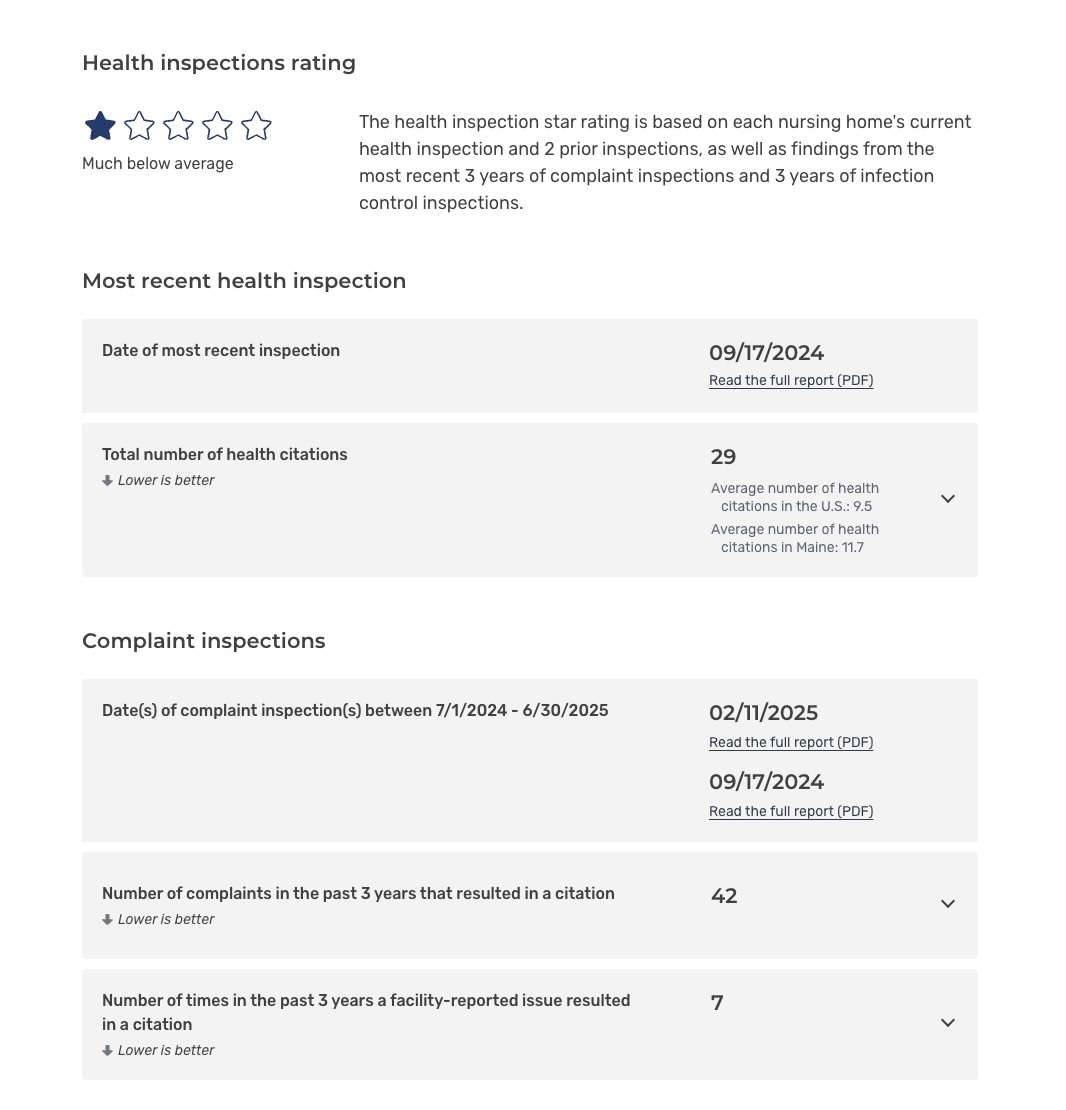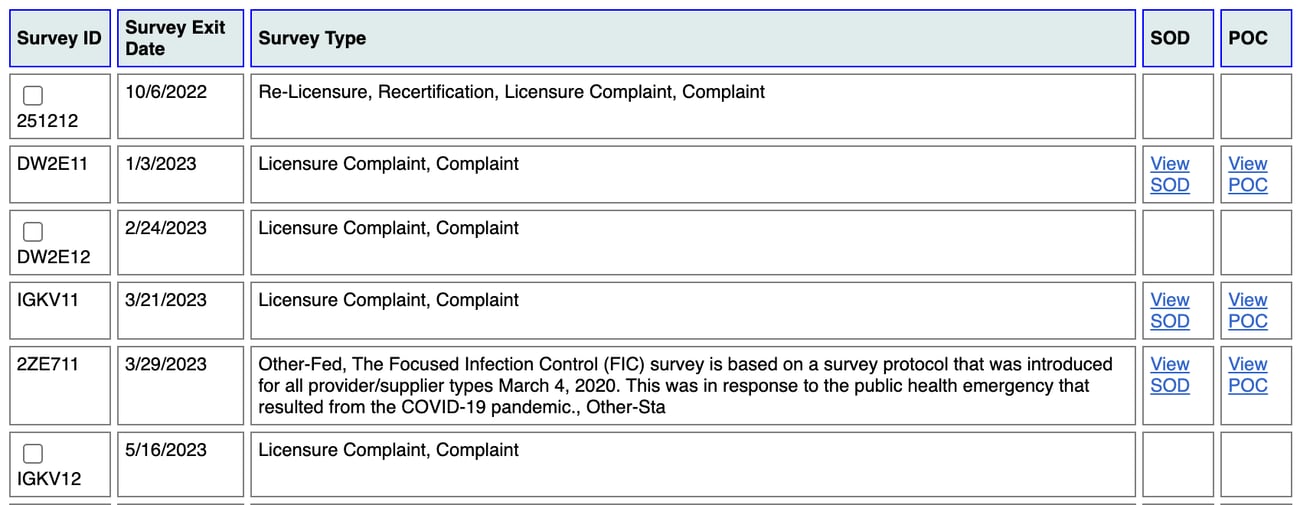|
|
 |
|
Photo by Garrick Hoffman |
|
|
|
|
|
Our guide to research nursing homes and assisted living facilities
Transitioning an older loved one into a nursing home or assisted living facility is difficult enough. Figuring out whether a facility will be safe and meet their needs can also be a daunting process, and it can be hard to know where to look for information. Through my years of reporting on these places, I’ve spent a lot of time digging through public databases that have a wealth of information, but they can be a bit confusing. I hope the guide below helps you find the information you need.
As you’re searching these resources for information on different facilities, here are some details to look out for:
Before getting into the databases, it’s important to understand the difference between nursing homes and assisted living facilities because it changes where to find information about each. Nursing homes are medical facilities and are regulated by a federal agency called the Centers for Medicare and Medicaid Services. Assisted living facilities are not considered medical facilities because they provide a lower level of care and they are state-regulated under the Maine Department of Health and Human Services.
Researching nursing homes
The best place to look up information on nursing homes is on the Nursing Home Care Compare website, from the Centers for Medicare and Medicaid Services. Each nursing home has an overall rating, out of five stars, based on health inspections, staffing levels and quality measures. Quality measures include rates of residents who received an antipsychotic medication, whose ability to move on their own worsened after entering the facility, who got a urinary tract infection, who lost too much weight or who went to the hospital, among many other metrics.
Under the health inspections tab on the website you can see the date of the most recent inspection and whether a facility received any citations related to the care of residents, how the staff and residents interact, and the nursing home environment. In the example below, we can see that this facility was cited for more regulatory violations than the national and state average. The most recent regular inspection report is available, as well as investigations spurred by complaints.
|
 |
|
The federal government provides public ratings for nursing homes around the country. |
|
The website also includes data on whether the facility was fined in the last three years, along with other information such as staffing turnover, the number of beds and the ownership type.
Also keep an eye out for whether a nursing home is flagged as a Special Focus Facility. This is a national list of facilities with “serious quality issues.”
If you want to know more about a specific incident that resulted in a financial penalty, ProPublica’s Nursing Home Inspect database is a great resource. It collects total fines, serious deficiencies and other data points. Under inspection reports, we can see which complaints resulted in a deficiency and how serious it was on a scale of A to L. “Immediate jeopardy” is the most concerning classification for an incident. ProPublica has tied incident records from CMS with any fines the facility received in recent years, so you can read the incident report that corresponds to a fine. (The CMS website lists the fines but does not link to the corresponding incident report.)
Finally, the Maine state licensing website provides all inspection reports in recent years. In the example below, there are two types of documents available. SOD refers to a Statement of Deficiency document. Each time the state inspects a facility, it produces this report, which lists any violations or notes if there were no deficiencies. Nursing homes that are found to have violations are required to submit a POC, or Plan of Correction, detailing how it will fix the problems.
|
 |
|
|
|
The Maine state licensing website provides all inspection reports from recent years. |
|
Researching assisted living and residential care facilities
This same state licensing website is where you can find information about assisted living facilities. From the homepage, select Assisted Housing. For the department, select Health and Human Services. For agency, select Division of Licensing and Regulation. From there, you can look up many different types of facilities, including residential care, assisted living, adult day services, hospice agencies and personal care services.
For residential care facilities, which resemble what are commonly known as assisted living facilities, you can look up the most recent inspections and see whether an investigator went to the facility. Investigators may visit the facility (an “on-site inspection”) or conduct a “desk review,” which means they conducted a review over the phone.
If the status says “No deficiencies,” that means state inspectors did not find any violations. If the status states “Accepted plan of correction,” that means the facility was cited for a violation and submitted a plan of correction back to the state about how it planned to address those problems.
The full results of these inspections and investigations are public record through a public records request to the state (any documents will be redacted to shield residents’ personal information). The Maine Monitor and ProPublica used these documents to investigate Maine’s residential care facilities, filing public records requests for three years’ worth of reports for nearly 200 of these facilities, which we used to create a database categorizing each individual violation. The result was an 18-month investigation that found these facilities were cited for dozens of resident rights violations including abuse and neglect incidents, more than a hundred cases where residents wandered away from their facilities and hundreds of medication and treatment violations.
The best way to decide where to place a loved one is to make sure you have all the available information. I hope this guide helps and don’t hesitate to reach out to me if you find anything interesting!
|
|
|
|
|
|
|
|
|
|
More than 20,500 workers at the Department of Health and Human Services – 18 percent – have left or been pushed out since the start of the Trump administration, according to a ProPublica analysis of federal worker departures.
The departures include more than 1,000 regulators and safety inspectors, and more than 3,000 scientists and public health specialists. ProPublica said the numbers are likely an undercount because there are hundreds or even thousands of workers who received layoff notices but remain on administrative leave.
“No health agency has been spared, with some important divisions losing more than 1 in 5 workers,” ProPublica reported. “The Centers for Disease Control and Prevention, in charge of public health, lost 15% of its staff; the National Institutes of Health, the largest funder of biomedical research in the world, 16%; and the Food and Drug Administration, which ensures the safety of most of what goes into people’s bodies — from baby formula to cancer drugs to hip implants — 21%.”
HHS did not dispute ProPublica’s findings but a spokesperson for the department “said the idea that Kennedy is weakening public health is ‘dishonest.’ ”
“Yes, we’ve made cuts — to bloated bureaucracies that were long overdue for accountability,” the spokesperson told ProPublica. “At the same time, we are working to redirect resources to science that delivers measurable impact, rebuilds public trust, and helps Make America Healthy Again.”
|
|
|
|
|
|
While The Maine Monitor does not place its content behind paywalls, some newsrooms we link to in this newsletter may. |
|
Northern Light pursuing mediation in last-ditch effort to resolve stalled negotiations with Anthem | Maine Public Radio
Northern Light reaches deal to lower health care costs for some Mainers, while talks with Anthem stall | Morning Sentinel
Waldo County opioid spending raises transparency questions | ICYMI from The Maine Monitor
State plans to take over Bangor’s public health nursing services | Bangor Daily News
Maine clinics denied Medicaid funds during lawsuit after Trump cuts to abortion providers | Associated Press
‘Law & Order’ creator Dick Wolf donates $10M to MDI Hospital | Bangor Daily News
After Calls for Transparency, Waldo County Forms Opioid Settlement Committee | Midcoast Villager
Brunswick 7-year-old advocates for diabetes research funding in D.C. | The Times Record
Local organizers call for policy change at overdose awareness rally | Bangor Daily News
Health care advocates are keeping a close eye on Northern Light and Anthem contract negotiations | News Center Maine
Modivcare files for bankruptcy amid legal fight over $750M Maine contract | News Center Maine
Maine Med addressing bat problem in neonatal intensive care unit | Portland Press Herald
Report warns hospitals in Aroostook, Ellsworth face imminent risk of closure due to Medicaid cuts | Maine Morning Star
Mosquitoes in Portland test positive for West Nile virus | Portland Press Herald
Amid anti-sunscreen movement, Maine dermatologists urge people not to discontinue use | Maine Public Radio
SNAP cuts could impact Maine’s free lunch for students in the long term | Portland Press Herald
What happens to the body under extreme heat? Medical tent at Beach to Beacon offers a glimpse | Portland Press Herald
How Aroostook is leading Maine at recruiting new nurses | Bangor Daily News
|
|
|
|
Get in touch: If you have any story suggestions, feedback or corrections, please never hesitate to reach out to me. I love hearing from readers: rose@themainemonitor.org.
The Maine Monitor is a publication of the Maine Center for Public Interest Reporting, an independent and nonpartisan nonprofit news organization that produces investigative journalism. We believe news is a public good and keep our news free to access. We have no paywall and do not charge for our newsletters. If you value the reporting we do for Maine, please consider making a donation! We cannot do this reporting without your support. |
|
|
|
|
|
|
|
|
|
|
|